
The pathway in the front garden crunch pleasingly underfoot. They are made of crushed oyster shells. (Photo by Kathy Jentz)
On a busy corner of that two-lane highway in Lewes, Del., sits an nearly 300-year-old home with a new garden surrounding it.
The front is a mosaic of textures, colors, and patterns — around the back, even more garden beds are stuffed full of treasures waiting to be discovered.
Holly H. Shimizu described her garden on Kings Highway as “close to a year-round garden as possible.”
She cultivates a casual look, but don’t be fooled, everything is well thought out.
“I let my annuals re-seed and then select what will stay,” Shimizu said.
She is a nationally recognized horticulturist, consultant and educator.
Five years ago, she retired from being the executive director of the U.S. Botanic Garden in Washington.
She now leads garden tours overseas, gives talks and consults with other public gardens.
Her husband, Osamu, is a garden designer, and together they recently designed and installed the new garden surrounding their weekend home in Lewes.
The historic home was built in 1730.
It is known as the Selby Hitchens House.
The original owner was a ship’s captain and the home had stayed in the family until 1911. It was lovingly restored by the previous owners, after decades of disrepair, and is credited with bringing on the revival of the town of Lewes.
There has also been a garden revival in Lewes.
In 2018, the town entered the 2018 Communities in Bloom international competition and has a mission of beautification and education. Visit lewesinbloom.org to learn more about touring the area’s gardens.
The Shimizu garden includes an entry dooryard garden of flavor and fragrance, a tea garden, fountains, and fences selected to bring unity and create a sense of place within the neighborhood.
The feel is both open and welcoming to passersby.
Entering through the back gate, visitors are surrounded by shady tranquility.
The small courtyard area seems worlds away from the busy front street traffic and is a perfect spot to enjoy the tea and cookies offered by the hosts.
The soothing sounds of burbling water are situated in several spots throughout the gardens.
Small water features tucked into beds here and there give the whole landscape a relaxing atmosphere, a reminder of the not-too-distant ocean shores.
Rounding the house to the front garden, one encounters some surprises — a small fairy garden full of enchanted figurines among dwarf conifers on the left, while on the right is a tropical bed stuffed full of zone-pushing plants like a Pomegranate tree heavy with the large fruit.
Along the side street fence is a series of vines — some flowering and all kept in check and respectful of each other’s space.
The pathway in the front garden crunch pleasingly underfoot.
hey are made of crushed oyster shells. Osamu confessed he bought them whole and crushed them himself to save a few dollars.
A small cottage sits directly on the front corner.
It has gone through several evolutions over the years from a feed store to a barbershop.
Holly and a garden writer friend even made a brief go of it as a gift shop, but closed it after one weekend “getting bored sitting around waiting for customers” Now, it is a cozy rental for vacationers looking for the perfect romantic getaway.
Near the cottage is Holly’s herb garden, which was inspired by Early American herb gardens.
Holly was the first curator of the National Herb Garden at the U.S. National Arboretum, during the 1980s. Her love of herbs is evident as she touches, smells and shares tastes of many of the selections she walks by. (Have you ever tasted the flower of a Pineapple Sage? A sweet and pleasant surprise!)
The front beds are a riot of color that somehow don’t outcompete the bright pink shutters on the house. There are beds stuffed with groundcovers and perennials including a shrub-sized toadlily bursting into the path.
Holly’s plant selection criteria are that they must be beautiful, beneficial for pollinators and birds, and thrive in their location without too much maintenance.
Gardening in sandy soil was a thrill after decades of battling compacted clay back at their home base in Glen Echo, Md. Their other local discovery was Pepper’s Greenhouses in Milton, Del., where they do a lot of their plant shopping for their coastal garden.
From the tall Castor bean plant to tiny native ferns, the eclectic plant choices in the Shimizus’ garden each add an element of surprise and delight.
Her advice to beginning gardeners is, “Just try it. We learn from our mistakes.”
(Editor’s note: Kathy Jentz is the Editor/Publisher of Washington Gardener Magazine. She can be reached at KathyJentz@gmail.com or 301-588-6894.





